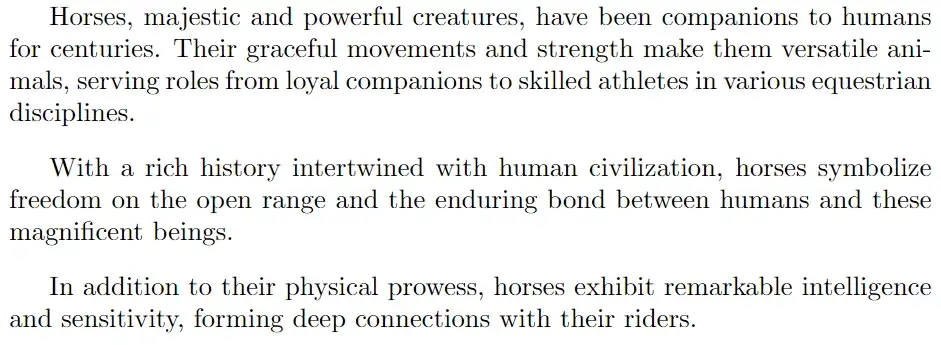Creating new paragraphs in LaTeX is an easy process. You can use some commands to control the appearance and spacing of paragraphs in your document. You can create a new paragraph using new line commands. But LaTeX provides special commands dedicated to paragraphs. In this article, we’ll discuss those commands.
Creating New Paragraphs
The basic command in LaTeX for creating a new paragraph is \par. To use \par in LaTeX, insert it in your document where you want to start a new paragraph. \par is a command that indicates the end of a paragraph and the beginning of a new one. Here’s an example.
\documentclass{article}
\begin{document}
Horses, majestic and powerful creatures, have been companions to humans for centuries. Their graceful movements and strength make them versatile animals, serving roles from loyal companions to skilled athletes in various equestrian disciplines.\par
With a rich history intertwined with human civilization, horses symbolize freedom on the open range and the enduring bond between humans and these magnificent beings.
\end{document}Output

The \par command prints the text in a new paragraph with some default indentation in the above example.
How do you Change the indentation of the paragraph?
You can customize paragraph indentation using \parindent. You can use \parindent command in the preamble to change the indentation of all the paragraphs. Suppose you want to change the indentation size for a paragraph to 20mm; you can use \parindent = 20mm command as described below.
\documentclass{article}
\parindent = 20mm
\begin{document}
Horses, majestic and powerful creatures, have been companions to humans for centuries. Their graceful movements and strength make them versatile animals, serving roles from loyal companions to skilled athletes in various equestrian disciplines.\par
With a rich history intertwined with human civilization, horses symbolize freedom on the open range and the enduring bond between humans and these magnificent beings.
\end{document}Output

Note: Set \parindent = 0mm to disable indentation. For example
\documentclass{article}
\parindent = 0mm
\begin{document}
Horses, majestic and powerful creatures, have been companions to humans for centuries. Their graceful movements and strength make them versatile animals, serving roles from loyal companions to skilled athletes in various equestrian disciplines.\par
With a rich history intertwined with human civilization, horses symbolize freedom on the open range and the enduring bond between humans and these magnificent beings.
\end{document}Output

Specific paragraph’s indentation
If you want to change a specific paragraph’s indentation, you can use the \noindent command after \par command. Here is an example.
\documentclass{article}
\begin{document}
Horses, majestic and powerful creatures, have been companions to humans for centuries. Their graceful movements and strength make them versatile animals, serving roles from loyal companions to skilled athletes in various equestrian disciplines.\par \noindent
With a rich history intertwined with human civilization, horses symbolize freedom on the open range and the enduring bond between humans and these magnificent beings.\par
In addition to their physical prowess, horses exhibit remarkable intelligence and sensitivity, forming deep connections with their riders.
\end{document}Output

Spacing Between Paragraphs
If you want to change the vertical space between paragraphs, you can use \parskip command in the preamble to set the vertical space. For example
\documentclass{article}
\parskip 3mm
\begin{document}
Horses, majestic and powerful creatures, have been companions to humans for centuries. Their graceful movements and strength make them versatile animals, serving roles from loyal companions to skilled athletes in various equestrian disciplines.\par
With a rich history intertwined with human civilization, horses symbolize freedom on the open range and the enduring bond between humans and these magnificent beings.\par
In addition to their physical prowess, horses exhibit remarkable intelligence and sensitivity, forming deep connections with their riders.
\end{document}Output

You can see from the above example that a vertical space of 3mm is created above all the paragraphs using the \parskip 3mm command.
Other ways to create a new paragraph
The \paragraph{} and \subparagraph{} commands are also used for creating new paragraphs, where the given arguments in {} serve as the headings for the paragraphs.
\documentclass{article}
\begin{document}
\paragraph{Horses:}
Horses, majestic and powerful creatures, have been companions to humans for centuries. Their graceful movements and strength make them versatile animals, serving roles from loyal companions to skilled athletes in various equestrian disciplines.
\subparagraph{Quality:}
In addition to their physical prowess, horses exhibit remarkable intelligence and sensitivity, forming deep connections with their riders.
\end{document}Output

In the above example, the \paragraph{} command displays its argument as the paragraph’s heading. Additionally, it initiates the first paragraph without indentation and introduces a predefined vertical space to separate it from the second paragraph.
The \subparagraph{} command, used for the second paragraph, produces an output similar to the \paragraph{} command, but with some default indentation at the beginning of the paragraph.
